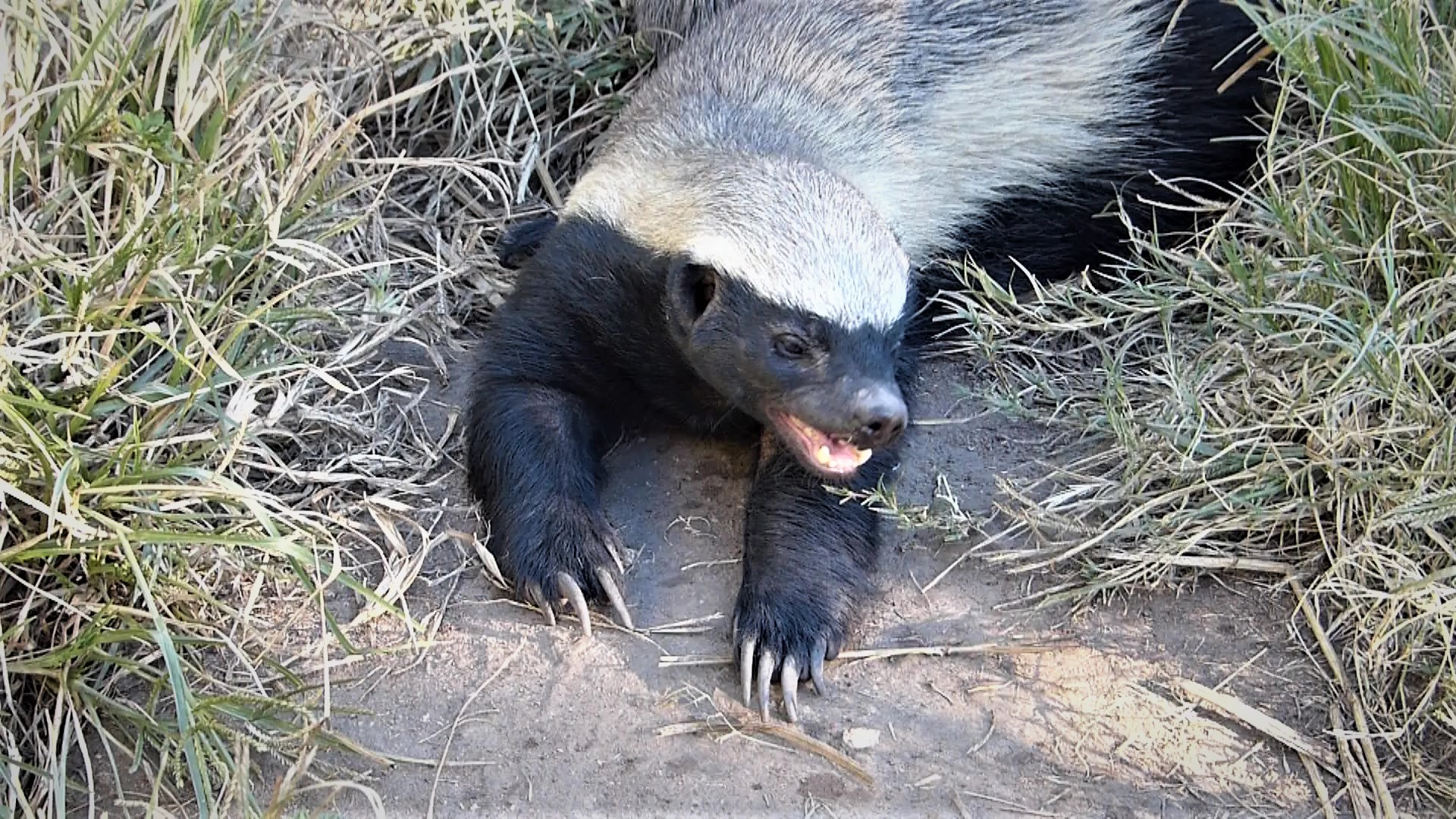There’s no doubt that honey badgers have a fearless “bad ass” attitude. Let’s see why.
Honey badgers, also known as ratels, regularly steal prey from leopards, attack and consume deadly snakes and scorpions, and successfully fight off lions and hyenas. One honey badger was observed grabbing a five-ton elephant by the trunk and another castrated a male buffalo! Cornering or antagonizing a honey badger would undoubtedly prove dangerous to any human foolish enough to try.
The honey badger has consistently been named “the world’s most fearless creature” by the Guinness Book of Records since 2002. Let’s take a deep look at what makes this crafty creature so fearless… and fearsome!
Honey badgers can be described as fearless hellions on four legs with an indomitable spirit backed up by physical attributes perfectly suited for combat.
9 Reasons Why Honey Badgers Deserve Your Respect:
- powerful jaws with sharp teeth that can crack bones
- long, sharp claws on their forefeet for digging, climbing, and defense/attack
- thick, resilient skin said to be impervious to spears and arrows
- a flexible spine that allows it to turn in its own skin and rip into any attacker
- amazing resistance to deadly snake venoms that would kill most similar sized animals
- reversible anal pouch that can spray a vile liquid with a mind-numbing stench
- ability to run backwards as an escape tactic
- boundless levels of aggression (honey badger don’t care!)
- tremendous intelligence, curiosity, and ability to problem-solve (i.e., escape artists extraordinaire)
The honey badger (Mellivora capensis) is a member of the Mustelidae family, which also includes weasels, otters, and wolverines. Anatomically it resembles a weasel/wolverine cross.
It is native to a large area from Africa through the Middle East to India.
What Are the Physical Attributes of the Honey Badger?
At first glance, a honey badger may not appear all that impressive – but don’t judge a killer by its fur coat!
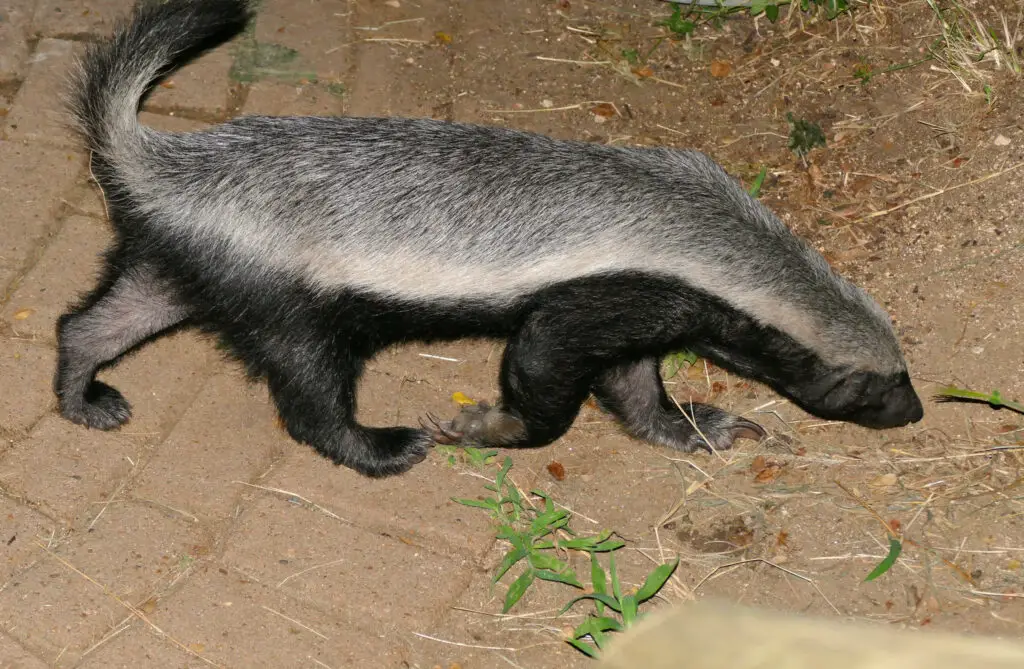
Tamboti Camp, Kruger NP, South Africa. Photo by Bernard Dupont Flickr CC By SA2
The honey badger has a bad-ass attitude – something like a cross between a pissed-off crocodile and a grumpy grizzly. In addition to attitude and fearlessness, the honey badger has a variety of weapons, including long claws, strong jaws with piercing teeth, and a tank-like profile made for headbutting.
This is one of the few mammals that can run backwards, and often uses this ability as a successful escape tactic when confronted by large predators such as lions and leopards.
Honey badgers, also referred to as ratels, are compact and muscular, with a thick skull, well-developed neck and shoulders, and strong forelegs equipped with enormous claws for digging. The black lower body and white upper body fur create an eye-catching pattern that continues to the tail.
They are about the size of a small to medium dog, weighing from about 13 pounds to about 30 pounds, and measure up to 40 inches (one meter) in length, including the tail. The spine is very flexible as well. They have small ears, eyes, and long, sharp claws are all perfectly suited for combat.
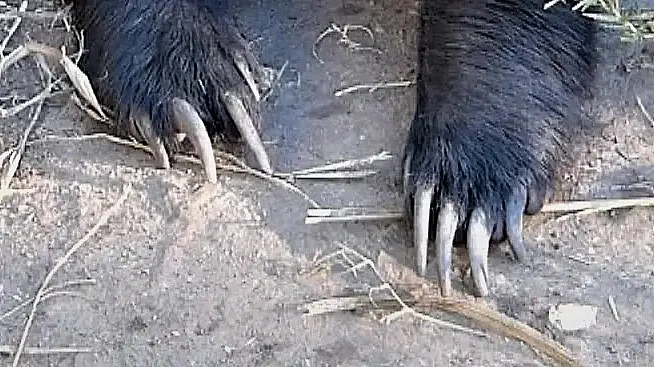
The honey badger has thick, resilient skin, with leathery patch around its neck that is rumored to be impervious to spears and arrows. Because of its extremely loose skin and flexible spine, the honey badger can turn around and unleash its wrath on any animal dumb enough to grab it by the neck.
Imagine yourself as a leopard with a honey badger attempting to steal your dinner. You might be tempted to grab the pesky intruder by its neck with your teeth. Consider your surprise when this flailing four-legged buzz-saw turns around in its own skin and rips your face in half!
With no external ears, a broad, muscular back, bowlegged front legs, and fearsome fore claws that can grow to 2 inches (40mm) in length, honey badgers are well adapted to their digging lifestyle. To keep out dirt while digging, they have internal ears that can be closed.
It also has a reversible anal pouch, which when used, emits a corrosive stench. In addition to warning strangers to “back off!”, this noxious fume is thought to calm angry African bees (or perhaps urge them to evacuate the hive?).
Let’s see why the Honey Badger is considered the scourge of the grasslands; terrorizing, impaling, and attacking animals at random while grabbing their prey, killing their young, and stealing their food.
How Intelligent are Honey Badgers?
Honey badgers are not only fearless and fearsome, but they also demonstrate fierce intelligence.
Honey badgers lead incredibly intricate ecological lives and have highly varied diets. Obtaining food and avoiding predators has honed their mental abilities to the point where they demonstrate great intelligence.
To test this intelligence, researchers have given captive honey badgers tests involving puzzle boxes that require a sequence of actions to open the door.
The badgers passed these tests with flying colors, corroborating long-held beliefs that they are excellent problem-solvers, in addition to being adventurous and adaptable.
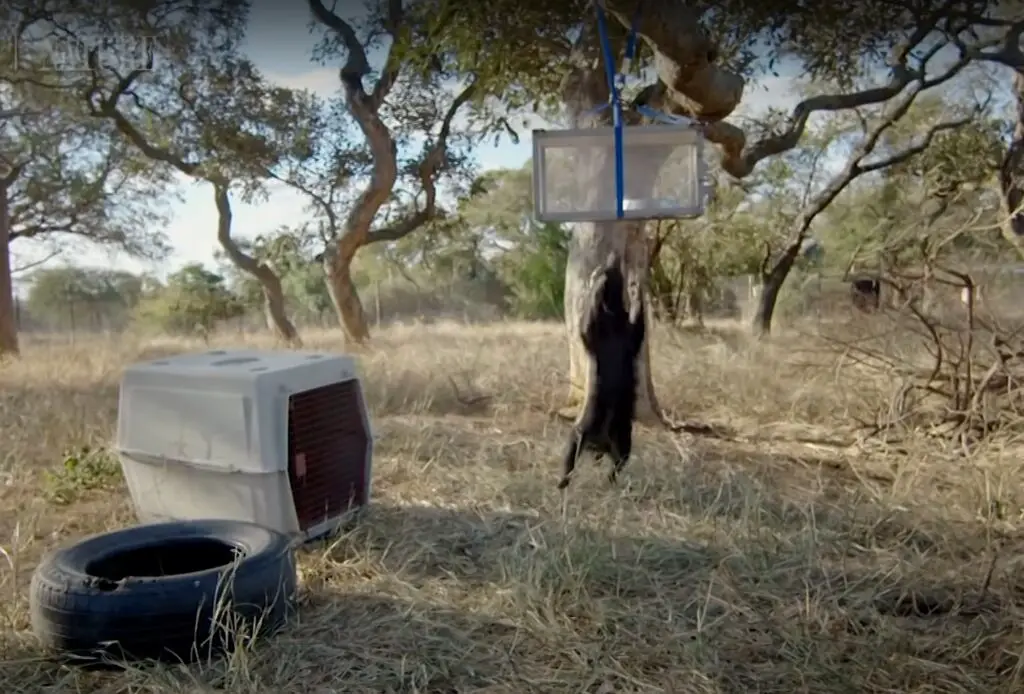
In a final test, food was placed in a box suspended from a tree so that the honey badgers could not access it directly from the ground.
They could only get to the box by dragging a nearby tractor tire or their cage underneath the box whereupon they could stand up and reach the food inside. If they could accomplish this, it would demonstrate their ability to use tools.
The honey badgers did indeed succeed by dragging their cage under the box and reaching the food inside.
Now that we know that honey badgers can use tools, they rank alongside some of the most intelligent and innovative creatures in the animal kingdom, such as chimpanzees and elephants.
This intellect gives honey badgers a great advantage in competing with other animals in the wild. Their intelligence is frequently interpreted as calculated and cunning, but, as we have seen, it is more than that. They are among the world’s smartest creatures!
Watch this excellent video showing the badgers using their brains in addition to their brawn.
What do Honey Badgers Eat?
The honey badger is an opportunistic carnivore and will consume almost anything it can find.
Aside from small mammals and the young of larger mammals, the honey badger will also eat birds, reptiles, insects, eggs, carrion, and some vegetation, such as juicy fruits. With its powerful jaws, it can even consume the shell of a turtle.
It consumes the entire animal, including the fur and bones, and much of its diet consists of food that it can dig out of burrows, such as rabbits.
Its name comes from the fact that it loves to feed on honey and bee larvae, which it obtains by raiding beehives, including the hives of killer bees. It typically escapes unharmed because the stings have difficulty penetrating its thick skin, and honey badgers have an amazing resistance to most venoms.
They can be strategic hunters. When digging for prey inside a burrow, they’ve been known to block the entrance with their long fore claws while digging a new entrance with their hind paws.
Although honey badgers are primarily nocturnal animals, they do become more active in the daytime during the cold, dry months.
Because honey badgers are tough and slow to tire, they frequently pursue larger prey by wearing them down through relentless “badgering.”
Can Honey Badgers Survive Deadly Snake Venom?

Honey badgers will regularly dine on venomous snakes and are often bitten in the process. They have been known to hunt and kill cobras, black mambas, and puff adders.
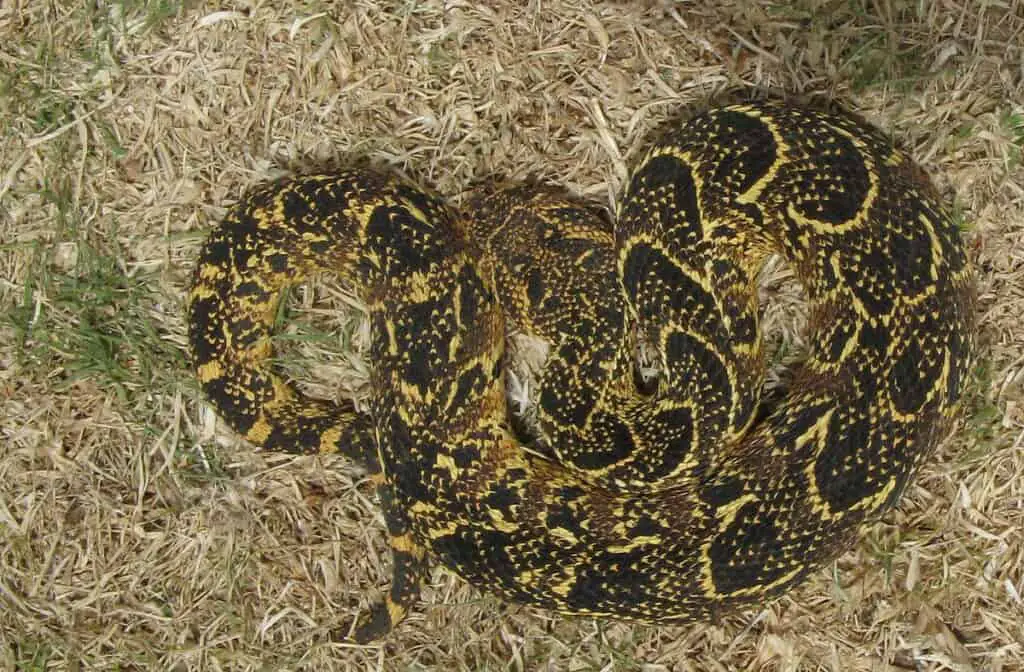
In this video, a male honey badger attacks a puff adder, considered the deadliest of African snakes. During the battle the puff adder manages to strike and inject its lethal venom. Puff adders are notorious for killing humans with a single bite.
The honey badger kills the snake and starts munching before collapsing. It appears to be dead. But not for long! He regains consciousness after a couple of hours and gets right back to the task at hand – chowing down on his hard-earned meal while looking unfazed by the entire ordeal.
Turns out that honey badgers have developed a natural resistance to the most powerful snake venoms. Through natural selection, they have evolved specialized receptors (muscular nicotinic cholinergic nAChR), which are the target of snake neurotoxins. These highly adapted receptors no longer bind the toxins in the snake venom (Drabeck et al 2015).
In Botswana, a large python nearly killed a ratel in an incident that was captured on camera. The honey badger managed to escape the boa constrictor’s grasp with a little “help” from a couple of irritating jackals fighting for the same meal.
It is thought that honey badgers build up resistance through exposure to venomous creatures. In this video a young honey badger tackles a scorpion gets stung several times, before turning its prey into a crunchy meal.
Do Honey Badgers Target the Genitals of Larger Animals?
According to legend, honey badgers target the scrotum when attacking large animals. This includes animals that you would think would be out of its league. A male buffalo, for example, weighs 2,000 lbs. (900 kg) and has vicious horns to boot.

In 1947, James Stevenson-Hamilton, the first warden of Kruger National Park in South Africa, recorded watching a honey badger castrate a male buffalo. His account continues, “Castrations by honey badgers have been recorded in other animals, including gnus, waterbucks, kudus, zebras, and man.” Yes, huMAN!
Doesn’t seem like a bad strategy if you have the nerve to tackle a beast the size of a tank. (As we’ve seen, honey badgers have plenty of nerve.) Rip into the testicles and wait for the animal to bleed to death. After all, a shot to the private parts would have very nasty consequences given those gnashing teeth and razor-sharp claws. (I wince even as I write this!)
Please note, in my research I haven’t managed to uncover any concrete proof that honey badgers use this tactic on wildebeest, waterbuck, kudu, zebras, or humans. Any volunteers out there? (Please contact me if you have such proof – the world needs your photos!)
How do Honey Badgers Make a Big Stink? Inside Out Anus
Honey badgers can turn their anus inside out and shoot a vile smelling liquid that would turn your stomach inside out!
The honey badger has two glands at the base of its tail that hold a foul liquid that is just as potent as that of a skunk. This vile, corrosive liquid is used as a defense against predators, to mark territory, and to intimidate competitors.
Some people think that the strong fumes act as a soporific for bees, but I haven’t seen any science to back this up.
The honey badger’s scent might not linger for very long, but it sends a strong message: “BACK OFF!”
How do Honey Badgers Mate and Raise Their Young?
Honey badgers typically live alone and keep a loose home range that frequently overlaps. When they meet, they might sniff each other and roll around to leave scent marks on the ground.
In contrast to females seen foraging with their cubs in their early months, males spend most of their time alone. During the mating season they are frequently spotted hunting in pairs.
To give birth and raise her young, the pregnant female honey badger digs a nursery chamber and lines it with grass. One cub (rarely two) is born after a 7-to-10-week gestation period. The infant has pink skin, no hair, and closed eyes. Its skin turns grey at one week old, and fine grey hair starts to appear at two weeks.
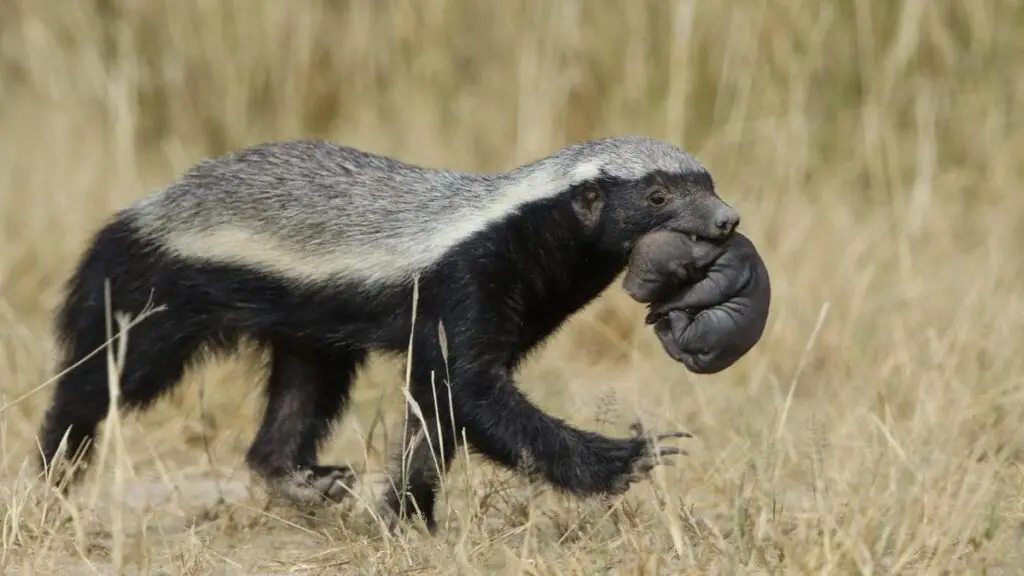
The full development of claws takes four weeks, and the full opening of the eyes takes about 33 days. Teeth begin to show up around 36 days, and they are fully developed around three months.
Interactions with Humans
Honey badgers frequently steal poultry and small livestock when they are near human populations, which makes them targets of retaliatory killings. They are frequently shot, speared, trapped, and poisoned.
They are the most destructive mammalian honeybee predators in Africa, second only to humans, and they can significantly harm both traditional and commercial beekeepers. Although a honey badger’s diet includes honey, they are primarily after the nourishing bee larvae.
This leads to conflict with those who keep bees for their honey. To safeguard their beehives, some beekeepers kill any honey badgers they come across.
Beekeepers can save themselves a great deal of grief through hive protection measures. Since honey badgers can’t jump, simply raising the beehives a few feet off the ground on metal posts deters honey badgers from climbing and protects the bees and their honey.
It is gratifying to know that a lot of beekeepers in Africa are now producing “badger-friendly honey”!
Conservation Status – Are Honey Badgers Endangered?
In some areas of their range, honey badgers are regarded as endangered because of human encroachment, which decreases their food supply.
Conservation status: Unprotected on the International Red Data List, Near Threatened in South Africa, Near Threatened in Morocco, Endangered in Saudi Arabia, protected in India. CITES: Appendix III (Botswana & Ghana)
Why are Honey Badgers called Ratels?
The Dutch word ratel, which is not too dissimilar from honey badger, means honeycomb.
The Afrikaans word for rattle is ratel, and the honey badger uses a loud rattling sound when it chooses to fight.
In addition to their deep, foreboding growl, honey badgers can grunt, squeak, hiss, and whine.
The Fun Story of Stoffel the Honey Badger
While on a trip to South Africa we made a point of visiting one special honey badger: Stoffel the famous escape artist.
Stoffel is over 18 years old (relatively old for the species), and lives in the Moholoholo Wildlife Rehabilitation Center in Africa. We can highly recommend a visit if you are near Kruger National Park.
Stoffel gained notoriety when handlers revealed that he had repeatedly escaped from his enclosure to attack a pride of lions (did he go after their tender bits?).
The lions attacked Stoffel in self-defense and the small, elderly badger was hospitalized. Most animals would be put off by being mauled by a pride of lions, but not Stoffel! As soon as he was discharged from the hospital, he once more broke out of his enclosure and attacked the lions.
When handlers placed Stoffel in a much tougher cage, he managed to escape by persuading his female partner to open the gate for him because, apparently, Stoffel is both a lover and a fighter.
After Stoffel scaled a tree and jumped over the fence to enter the center’s kitchens and attack an eagle, they removed the trees and double-locked the gate.
They built an expensive concrete enclosure for Stoffel. He responded by digging up a lot of rocks, piling them up in one corner of his enclosure, and using the rocks to climb the fence.
Stoffel’s handlers decided extreme measures were necessary and took everything out of his enclosure, leaving only bare dirt. At first this presented a challenge, but Stoffel thrives on challenges. He took the dirt, gathered it all into a large ball, hopped the fence once more, and then, just for kicks, broke into his handlers’ home.
Watch Stoffel the Escape Artist in this wonderful BBC clip:
Makes one pause to reflect on the wisdom of trying to keep a honey badger locked up in the first place! Especially given their propensity for escaping from any enclosure and their tendency to “go for the balls” when tackling humans and other large mammals.
You might think that Stoffel is an exceptionally intelligent honey badger. He is, in fact, quite typical, and just “taking care of business” as any self-respecting wild honey badger would do… creating mayhem and carnage along the way.
References
Begg, C.M. 2006. Feeding ecology and social organisation of honey badgers (Mellivora capensis) in the southern Kalahari. Doctoral dissertation, University of Pretoria.
Drabeck DH, Dean AM, Jansa SA. (2015) Why the honey badger don’t care: Convergent evolution of venom-targeted nicotinic acetylcholine receptors in mammals that survive venomous snake bites. Toxicon. 2015 Jun 1;99:68-72. doi: 10.1016/j.toxicon.2015.03.007. Epub 2015 Mar 18. PMID: 25796346.

